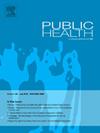What pushes males to marry underage girls? Demand-side insights of child marriage from northern Bangladesh
IF 3.2
3区 医学
Q1 PUBLIC, ENVIRONMENTAL & OCCUPATIONAL HEALTH
引用次数: 0
Abstract
Objectives
This study aims to assess the factors that drive males to marry underage girls (i.e., girls below the legal age of marriage), with a specific focus on how individual, household, and contextual characteristics of males relate to the prevalence of child marriage in geographically isolated areas, particularly the riverine islands (chars) of Bangladesh.
Study design
This study employs a cross-sectional design, which is appropriate for capturing data at a single point in time. In this case, data were collected between March and April 2024.
Methods
With a sample of 5415 individuals, the study applied multilevel mixed-effects Poisson regression to identify factors associated with male preferences for child marriage of girls. Results are reported as incidence rate ratios (IRRs).
Results
Younger males had a 29 % higher likelihood of marrying underage girls (IRR = 1.29, 95 % confidence interval [CI] = 1.26, 1.33). Self-employed men were 12 % more likely to engage in child marriage (IRR = 1.14, 95 % CI = 0.99, 1.30). Socioeconomic status influenced risk, with moderately poor (IRR = 1.08, 95 % CI = 1.02, 1.14) and non-poor (IRR = 1.04, 95 % CI = 1.00, 1.08) households showing slightly elevated likelihoods of engaging in child marriage compared to extremely poor households. While the main effect of education alone was not statistically significant (IRR = 0.99, 95 % CI = 0.96, 1.02), among moderately poor households, each additional year of schooling was associated with a reduction in the risk of marrying underage girls (IRR = 0.98, 95 % CI = 0.97, 1.00). This indicates that education may act as a protective factor, especially in certain socioeconomic contexts, by reducing the influence of poverty or informal employment on child marriage decisions.
Conclusions
Overall, this study reinforces the notion that, beyond economic status, education plays a critical role in reducing the tendency of men to marry underage girls. Therefore, interventions should focus on promoting male education, engaging younger and self-employed men in awareness programs, and integrating child marriage prevention strategies with broader infrastructure development efforts.
是什么促使男性与未成年女孩结婚?来自孟加拉国北部的童婚需求方洞察
本研究旨在评估促使男性与未成年女孩(即低于法定结婚年龄的女孩)结婚的因素,特别关注男性的个人、家庭和背景特征如何与地理上孤立的地区,特别是孟加拉国的河流岛屿(chars)的童婚流行有关。研究设计本研究采用横断面设计,适合于在单一时间点获取数据。在这种情况下,数据是在2024年3月至4月期间收集的。方法采用多水平混合效应泊松回归分析5415人的样本,分析男性偏好女童童婚的相关因素。结果以发病率比(IRRs)报告。结果年轻男性与未成年少女结婚的可能性高29% (IRR = 1.29, 95%可信区间[CI] = 1.26, 1.33)。自雇男性发生童婚的可能性高出12% (IRR = 1.14, 95% CI = 0.99, 1.30)。社会经济地位影响风险,中等贫困家庭(IRR = 1.08, 95% CI = 1.02, 1.14)和非贫困家庭(IRR = 1.04, 95% CI = 1.00, 1.08)与极端贫困家庭相比,发生童婚的可能性略高。虽然教育本身的主要影响在统计上并不显著(IRR = 0.99, 95% CI = 0.96, 1.02),但在中等贫困家庭中,每增加一年的学校教育与与未成年女孩结婚的风险降低有关(IRR = 0.98, 95% CI = 0.97, 1.00)。这表明,教育可以作为一种保护因素,特别是在某些社会经济背景下,通过减少贫困或非正规就业对童婚决定的影响。总的来说,这项研究强化了这样一种观念,即除了经济地位之外,教育在减少男性与未成年女孩结婚的倾向方面起着关键作用。因此,干预措施应侧重于促进男性教育,让年轻男性和自雇男性参与提高认识项目,并将预防童婚战略与更广泛的基础设施发展工作相结合。
本文章由计算机程序翻译,如有差异,请以英文原文为准。
求助全文
约1分钟内获得全文
求助全文
来源期刊

Public Health
医学-公共卫生、环境卫生与职业卫生
CiteScore
7.60
自引率
0.00%
发文量
280
审稿时长
37 days
期刊介绍:
Public Health is an international, multidisciplinary peer-reviewed journal. It publishes original papers, reviews and short reports on all aspects of the science, philosophy, and practice of public health.
 求助内容:
求助内容: 应助结果提醒方式:
应助结果提醒方式:


